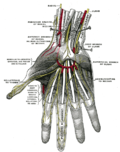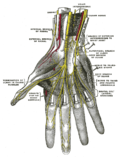| Radial nerve | |
|---|---|
 The suprascapular, axillary, and radial nerves | |
| Details | |
| From | Posterior cord |
| To | Posterior interosseous nerve |
| Innervates | Posterior compartment of the arm, posterior compartment of the forearm |
| Identifiers | |
| Latin | nervus radialis |
| MeSH | D011826 |
| TA98 | A14.2.03.049 |
| TA2 | 6431 |
| FMA | 37069 |
| Anatomical terms of neuroanatomy | |
The radial nerve is a nerve in the human body that supplies the posterior portion of the upper limb. It innervates the medial and lateral heads of the triceps brachii muscle of the arm, as well as all 12 muscles in the posterior osteofascial compartment of the forearm and the associated joints and overlying skin.
Contents
- Structure
- Arm
- Forearm and hand
- Variation
- Function
- Cutaneous
- Motor
- Clinical significance
- Injury
- History
- Additional images
- See also
- References
- External links
It originates from the brachial plexus, carrying fibers from the posterior roots of spinal nerves C5, C6, C7, C8 and T1. [1]
The radial nerve and its branches provide motor innervation to the dorsal arm muscles (the triceps brachii and the anconeus) and the extrinsic extensors of the wrists and hands; it also provides cutaneous sensory innervation to most of the back of the hand, except for the back of the little finger and adjacent half of the ring finger (which are innervated by the ulnar nerve).
The radial nerve divides into a deep branch, which becomes the posterior interosseous nerve, and a superficial branch, which goes on to innervate the dorsum (back) of the hand.
This nerve was historically referred to as the musculospiral nerve. [2]

















